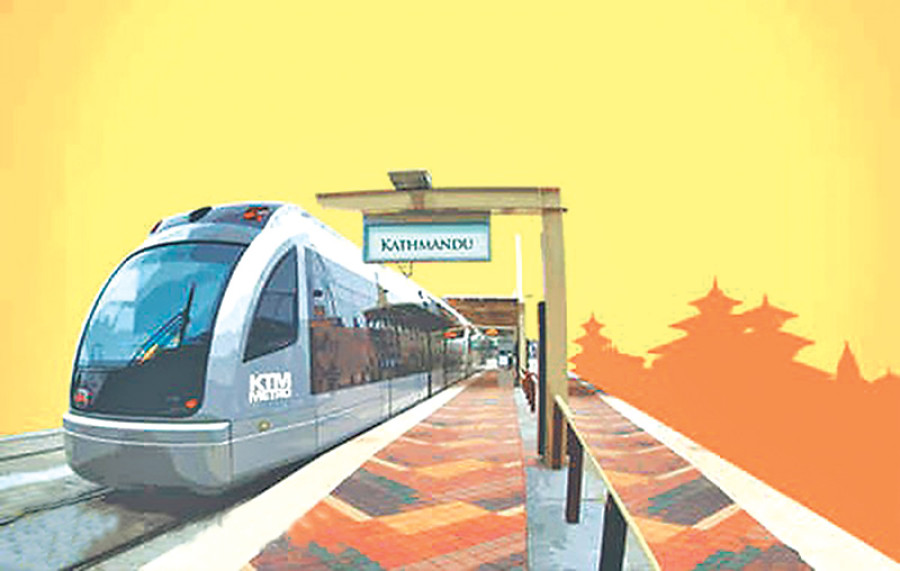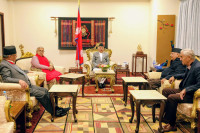Opinion
A metro for the metro
With a population of around 5 million, the Kathmandu Valley is in dire need of a public transportation system that is reliable, safe and comfortable.
Ashish Gajurel
With a population of around 5 million, the Kathmandu Valley is in dire need of a public transportation system that is reliable, safe and comfortable. Traffic is getting worse by the day mainly because of an exponential growth in the number of private vehicles and absence of reliable public transportation. Registrations of private autos in Bagmati zone shot up 77 percent in 2015-16 compared to 2014-15. In recent years, some roads have been widened and a few bus companies have introduced high capacity buses; but this is no long-term solution. What the Valley needs is an integrated transit system that chiefly comprises bus and rail systems.
In 2012, the Ministry of Physical Infrastructure and Transport prepared a detailed feasibility study (DFS) for a Kathmandu Valley metro system through a Korean consulting firm Chungsuk Engineering. The survey has recommended a 77.28-km-long rail system with five routes. The five routes are the Ring Road and four diametric routes with the centre at Jamal. The project is estimated to cost Rs550 billion ($5.5 billion) and take 14 years to complete.
First, the government must be clear about the modality to be adopted, and the failure of the Kathmandu-Tarai Fast Track should be taken as a lesson. The government had accorded top priority to the expressway which would be built under the public-private partnership (PPP) model. A global tender notice was published in 2008 to develop the project. There were no takers and two more notices were issued. Following the third call in 2014, an Indian consortium IL&FS was selected to develop the project under the build-operate-transfer (BOT) model. The government began negotiations with IL&FS which were not successful, and it eventually decided to develop the project with its own funds. The project has been in limbo since then.
International examples
The Delhi Metro project is a success story in the history of metro development. In the beginning, Delhi Metro Rail Corporation (DMRC) was incorporated under the Indian Companies Act. This was followed by the enactment of the Delhi Metro Act. The 420-km-long Delhi Metro would be developed in four stages. The construction of the 65-km first phase began in 2005, and it was completed almost three years ahead of schedule. It cost $2.5 billion. This works out at around Rs4 billon per kilometre.
On the financing front, 20 percent came from the central government, 20 percent from the state government, 55 percent from the Japanese International Cooperation Agency (Jica) as a soft loan and the remaining 5 percent was accumulated through property development. The project showed a profit from day one. The economic rate of return of the first phase was 20 percent. The project’s success can be attributed to the independent DMRC and the Delhi Metro Act. The DMRC independently implements its vision and recruits the necessary manpower without any political intervention.
Dubai Metro is another project which can be a good reference for the government of Nepal. The 35-km first phase was initiated in 2005 and was completed in 2009. The project cost $7.8 billion, which works out at Rs22 billion per kilometre. The system was designed and constructed by Japanese and Turkish firms, and the project management and construction management was done by French and American companies. The project experienced cost and time overruns due to a change in the scope.
The variance in the construction cost of the metro is attributable to factors like geographical differences, differences in soil condition, availability of raw materials and availability of manpower, among others. Spain recently built a subway system in Madrid that cost Rs6 billion per kilometre while the expansion of metro lines in Berlin and Paris cost Rs25 billion per kilometre. In Nepal’s context, foreign firms can be consulted for the design and engineering, and the required capital can be put together through foreign direct investment, concessional loans or the government’s own money. The most important aspect is having the will to build it.
Moving forward
Without wasting a single minute, the government must immediately bring its plan of action on the development of the metro project. The feasibility study report prepared by the Korean company is already four years old. Based on this study, the government can prepare a DPR of at least one easy route and initiate construction of the project. A potential route might be building elevated tracks on the 28-km-long Ring Road. The government can identify suitable routes leading to the city centre.
The construction of a metro line is challenging in the core city areas of the Valley as they are densely populated. If the government decides to develop the project under the PPP model, it should be ready to provide the necessary viability gap funding (VGF) to make the project financially viable to the private sector. The government can also adopt the strategy of Delhi Metro and finance the project through soft loans from multilateral and bilateral organisations and its own resources. Since experience shows that potential developers are not keen about building rail projects under the PPP model, the government can build the project itself and invite the private sector to handle operations, management and maintenance.
Gajurel is a transportation engineer




 13.12°C Kathmandu
13.12°C Kathmandu











